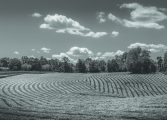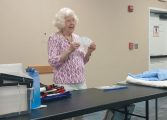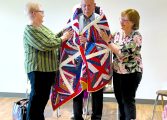By Page H. Gifford
Correspondent
Artist Amy Shawley gave an online demonstration on acrylic paints and mediums to the members of the Fluvanna Art Association at their monthly meeting on Friday, Oct. 21. She explained the many aspects of various paints and mediums that when mixed create one-of-kind pieces of art.
For decades acrylics bridged the gap between the long drawn-out waiting times for oils to dry and the skill needed to control watercolors. Acrylics offered the best of both worlds, from fast drying to ease of painting.
Invented in 1934 by Sam Golden and Leonard Bocour, acrylics are not a new medium but not as old as oil or watercolor. It was Golden who developed his product in the 1940s in a small paint maker’s shop in New York City. Golden also had classes demonstrating his paints and connecting with up-and-coming young artists hungry for something new and exciting. He continued to develop his paints through the ‘50s and ‘60s. After retiring and moving to New Berlin, N.Y., Golden and his son set up manufacturing their paint in a barn. Golden Products has been the staple for acrylic artists since 1980 and they have recently added oils and watercolors to their line of paints and mediums.
Many artists are delving into mixed media, oil with acrylic, watercolor with acrylic, or with pastel, etc. Artists are explorers when it comes to mixed media and testing infinite possibilities.
“I like the texture of impasto,” said Shawley, who pointed out that building it with traditional oils is costly by using more pigment. “I can do this with a heavy gel mat and use less pigment.” The gels and pastes that she refers to are colorless blenders that act like the paint itself but when mixed with pigmented acrylic paint or other mediums can give a painting or a piece of artwork a different look and a different style.
The most common additive that came on the market and changed acrylic’s elements was the extender which extended the drying time for acrylics so the artist had more time to work on a painting before it is completely dried.
Made mostly of plastic and water, acrylic drying times depended on water evaporation.
“It depends on environmental factors, humid versus cold, how fast water will evaporate,” she said. It is mind-boggling how many products are out there, depending on the certain look an artist is trying to achieve. There is an art and science in understanding acrylics.
Many of these products can be mixed with watercolor or watercolor used as an underpainting for acrylics. She showed how to manipulate various colors by softening edges with water for an acrylic wash.
“There continues to be debate regarding how much water to add to acrylics but you can use quite a bit depending on the paper or canvas you are using.”
Certain products can be used in creating layers and glazes with acrylic pigments. Many have a different look including the fluid acrylic which moves but maintains its body, unlike the hi-flow acrylic which acts more like ink and can be used with an airbrush, empty paint markers, pen nibs, and tech pens for drawing. Both of these come in bottles, not the traditional tube. So flat mimics gouache, an opaque watercolor that looks like tempera paint but when dry, drawings can be made on it.
Shawley discussed low and high viscosity which is the movement of the paint that matters to artists based on their brushstrokes and how much control they want to achieve a certain look.
Yet, many of the gels and pastes add a different look such as more clarity with a gel and less sheen and more texture with a mat.
Shawley, having been a representative for 15 years with Golden, doesn’t knock the competitors.
“They add a binder to have a consistent sheen across pigments but this tends to dilute the intensity. But you can mix other brands with Golden.” She stressed the key to understanding any paint is to interpret how color behaves.
“Understanding the intensity of your pigment and ratios is helpful when mixing various colors. Also, understanding color temperature helps in creating mood in paintings.”
Many other items can be used to create art, including gelatin printing plates or Gelli plates that can transform artwork and photos and mix it with collages. Molding paste, glass bead gel, fiber paste, and pumice gel all give work a different look. The opportunities for creation are endless and only limited by one’s imagination.




